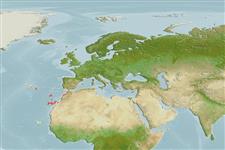Environment: milieu / climate zone / depth range / distribution range
Ökologie
seewasser demersal; tiefenbereich 3 - 23 m (Ref. 36120), usually 11 - 20 m (Ref. 36120). Temperate; 40°N - 15°N
Eastern Atlantic: Azores, Madeira, Canary, Cape Verde Islands and Senegal.
Size / Gewicht / Alter
Maturity: Lm ? range ? - ? cm
Max length : 8.0 cm SL Männchen/unbestimmt; (Ref. 36120)
Kurzbeschreibung
Morphologie | Morphometrie
Rückenflossenstacheln (insgesamt): 0; Rückenflossenweichstrahlen (insgesamt): 80-87; Afterflossenstacheln 0; Afterflossenweichstrahlen: 66 - 72; Wirbelzahl: 45 - 48. a 1-3-2 interdigitation pattern; 12 caudal fin rays; 80-87 dorsal fin rays; 66-72 anal fin rays; 45-48 total vertebrae; 84-98 scales in a longitudinal series; unpigmented peritoneum; unique ocular side pigmentation featuring a yellowish to dark brown background with numerous small, dark speckles, a series of 3-8 mostly incomplete crossbands beginning just posterior to the opercle, and usually 1-3 small, dark, spherical spots arranged in a longitudinal row along the body midline; a series of dark blotches alternating with unpigmented areas on the dorsal and anal fins, and a spot and dark band on the caudal fin base with the distal four-fifths of the caudal fin unpigmented.
Life cycle and mating behavior
Geschlechtsreife | Fortpflanzung | Ablaichen | Eier | Fecundity | Larven
Munroe, T.A., A. Brito and C. Hernandez, 2000. Symphurus insularis: a new Eastern Atlantic dwarf tonguefish (Cynoglossidae: Pleuronectiformes). Copeia 2000(2):491-500. (Ref. 36120)
IUCN Rote Liste Status (Ref. 130435)
Bedrohung für Menschen
Harmless
Nutzung durch Menschen
Fischereien: nicht kommerziell
Mehr Information
NamenSynonymeMetabolismusRäuberÖkotoxikologieFortpflanzungGeschlechtsreifeAblaichenSpawning aggregationFecundityEierEientwicklung
Alter/GrößeWachstumLänge-GewichtLänge-LängeLängenhäufigkeitenMorphometrieMorphologieLarvenLarven Pop.Dyn.RekrutierungDichteBRUVS
ReferenzenAquakulturAquakultur ProfilZuchtlinienGenetikElectrophoresesVererbbarkeitKrankheitenVerarbeitungNutrientsMass conversion
PartnerBilderStamps, Coins Misc.LauteCiguateraGeschwindigkeitSchwimmstilKiemenoberflächeOtolithsGehirngrößeSehfähigkeit
Tools
Zusatzinformationen
Download XML
Internet Quellen
Estimates based on models
Preferred temperature (Ref.
123201): 18.8 - 21.2, mean 19.9 °C (based on 56 cells).
Phylogenetic diversity index (Ref.
82804): PD
50 = 0.5000 [Uniqueness, from 0.5 = low to 2.0 = high].
Bayesian length-weight: a=0.01445 (0.00647 - 0.03228), b=3.05 (2.85 - 3.25), in cm total length, based on LWR estimates for this (Sub)family-body shape (Ref.
93245).
Trophic level (Ref.
69278): 3.2 ±0.4 se; based on size and trophs of closest relatives
Widerstandsfähigkeit (Ref.
120179): hoch, Verdopplung der Population dauert weniger als 15 Monate. (Preliminary K or Fecundity.).
Fishing Vulnerability (Ref.
59153): Low vulnerability (10 of 100).
